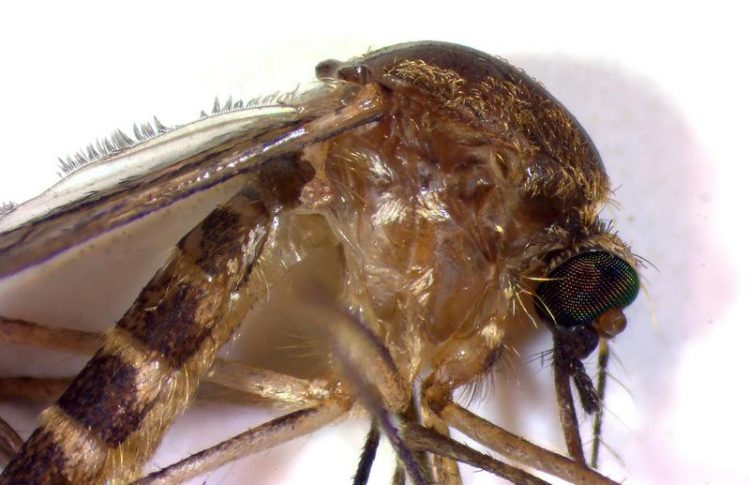Hybrid forms of the common house mosquito may serve as vectors between birds and humans

Different forms of the northern house mosquito are morphologically indistinct. Carina Zittra/Vetmeduni Vienna
The team of researchers from the Institute of Parasitology at Vetmeduni Vienna sampled nearly 1,500 house mosquitoes in eastern Austria. The northern house mosquito Culex pipiens, representing more than 90% of the total catch, was the most abundant.
Culex pipiens comprises a complex of ecologically different forms that are morphologically indistinct. Two of these forms are endemic to eastern Austria. First author of the study Carina Zittra has now succeeded in identifying a hybrid of these two forms.
Hybrid of ecological forms with different preferences
By far the most common ecological form collected was Culex pipiens f. pipiens. This form prefers to feed on avian blood, reproduces in mating swarms and requires a blood meal as a protein supplement before the first egg-laying. It also hibernates. The second ecological form, Culex pipiens f. molestus, prefers the blood of mammals including humans. It reproduces through single mating, does not require an initial blood meal and does not hibernate. This mammalophilic form of the house mosquito can therefore bite in the winter as well.
“The hybrid form identified by us is a natural hybrid of these two house mosquito forms,” says Zittra. Further studies are needed to determine which of these different lifestyles the hybrid prefers. However, the researchers do not expect the hybrid to show such a clear blood preference as the two common forms of Culex pipiens.
Hybrids could serve as bridge vectors
When mosquitoes feed, they don’t only suck blood. They can also transmit exotic diseases such as the West Nile virus. Migratory birds are one way these diseases can come to Austria. A transmission from bird to mammal is unlikely, however, as long as mosquitoes such as the ornithophilic Culex pipiens f. pipens remain loyal to their respective source of blood.
According to Zittra, however, the newly discovered hybrids are known not to have a clear preference for the blood of just one type of animal. This raises the possibility that they could become so-called bridge vectors. That means that the hybrid picks up a pathogen from its original host, the bird, and may transmit it to other birds or other species such as humans.
The frequency of hybrids is currently rather low. “We should not disregard the possible presence of hybrid forms in future screenings, however, especially as the hybrids are capable of reproducing,” Zittra adds.
Minimizing the mosquito population
House mosquitos only need a source of standing water for egg-laying, such as plant and flower water or water that has collected in the rain barrel or a toy in the garden. Reservoirs like these should be regularly emptied and care should be taken to prevent standing water or wet areas in order to eliminate potential mosquito breeding habitat.
Zittra also has a valuable tip regarding UV lamps as mosquito traps. “Mosquitoes find their victims by sensing the carbon dioxide released from breath, body temperature and sweat. They are not attracted to light sources – after all, they also bite at night. UV lamps therefore don’t offer much help, except that they attract other, useful insects.”
Service
The article “Ecological characterization and molecular differentiation of Culex pipiens complex taxa and Culex torrentium in Eastern Austria“ by Carina Zittra, Eva Flechl, Michael Kothmayer, Simon Vitecek, Heidemarie Rossiter, Thomas Zechmeister and Hans-Peter Fuehrer was published in the journal Parasites & Vectors veröffentlicht. doi: 10.1186/s13071-016-1495-4
http://parasitesandvectors.biomedcentral.com/articles/10.1186/s13071-016-1495-4
About the University of Veterinary Medicine, Vienna
The University of Veterinary Medicine, Vienna in Austria is one of the leading academic and research institutions in the field of Veterinary Sciences in Europe. About 1,300 employees and 2,300 students work on the campus in the north of Vienna which also houses five university clinics and various research sites. Outside of Vienna the university operates Teaching and Research Farms. http://www.vetmeduni.ac.at
Scientific Contact:
Carina Zittra
Institute of Parasitology
University of Veterinary Medicine Vienna (Vetmeduni Vienna)
T +43 1 25077-2205
carina.zittra@vetmeduni.ac.at
Released by:
Georg Mair
Science Communication / Corporate Communications
University of Veterinary Medicine Vienna (Vetmeduni Vienna)
T +43 1 25077-1165
georg.mair@vetmeduni.ac.at
http://www.vetmeduni.ac.at/en/infoservice/presseinformation/presseinformationen-…
Media Contact
All latest news from the category: Life Sciences and Chemistry
Articles and reports from the Life Sciences and chemistry area deal with applied and basic research into modern biology, chemistry and human medicine.
Valuable information can be found on a range of life sciences fields including bacteriology, biochemistry, bionics, bioinformatics, biophysics, biotechnology, genetics, geobotany, human biology, marine biology, microbiology, molecular biology, cellular biology, zoology, bioinorganic chemistry, microchemistry and environmental chemistry.
Newest articles

Silicon Carbide Innovation Alliance to drive industrial-scale semiconductor work
Known for its ability to withstand extreme environments and high voltages, silicon carbide (SiC) is a semiconducting material made up of silicon and carbon atoms arranged into crystals that is…

New SPECT/CT technique shows impressive biomarker identification
…offers increased access for prostate cancer patients. A novel SPECT/CT acquisition method can accurately detect radiopharmaceutical biodistribution in a convenient manner for prostate cancer patients, opening the door for more…

How 3D printers can give robots a soft touch
Soft skin coverings and touch sensors have emerged as a promising feature for robots that are both safer and more intuitive for human interaction, but they are expensive and difficult…





















